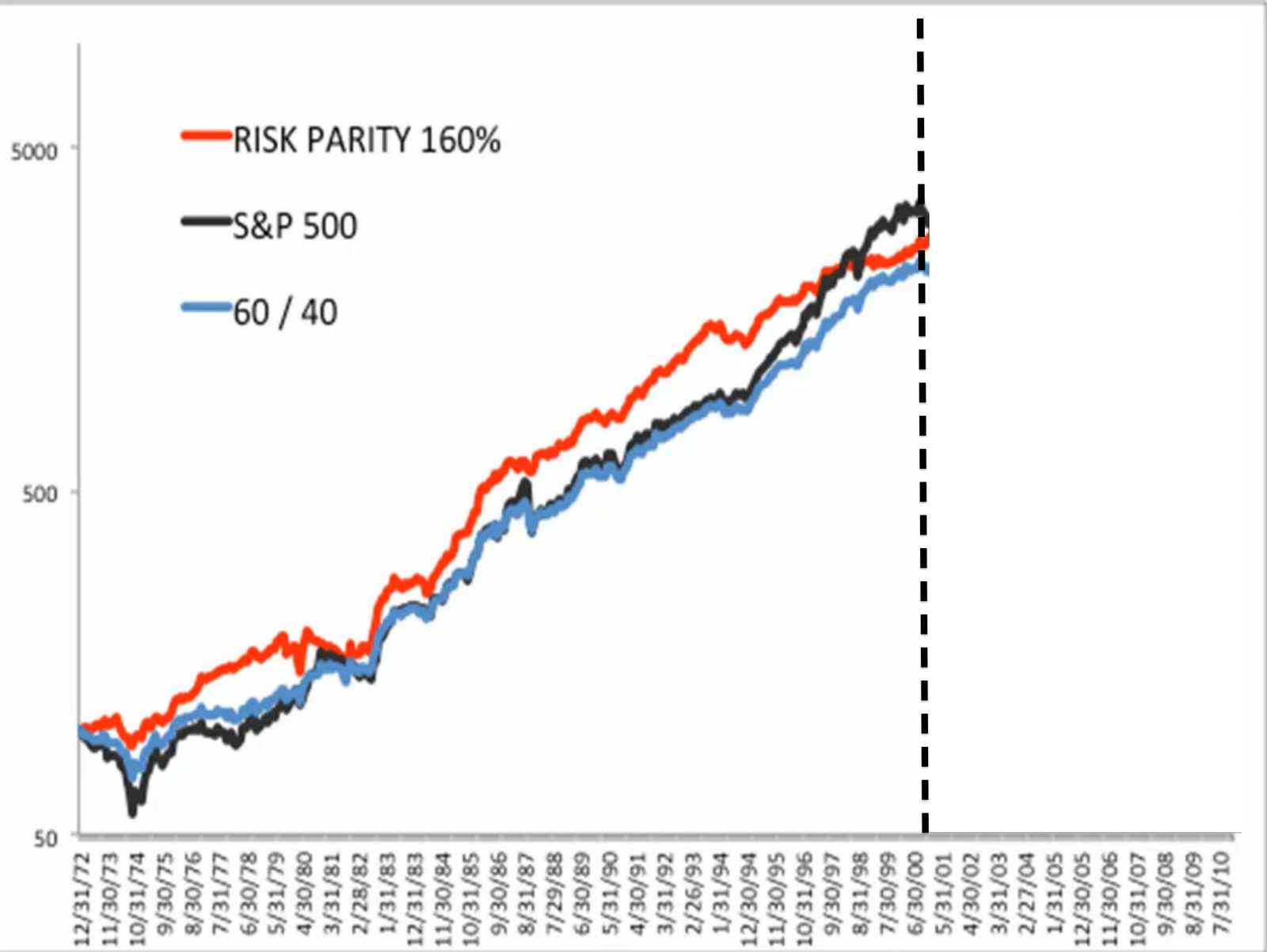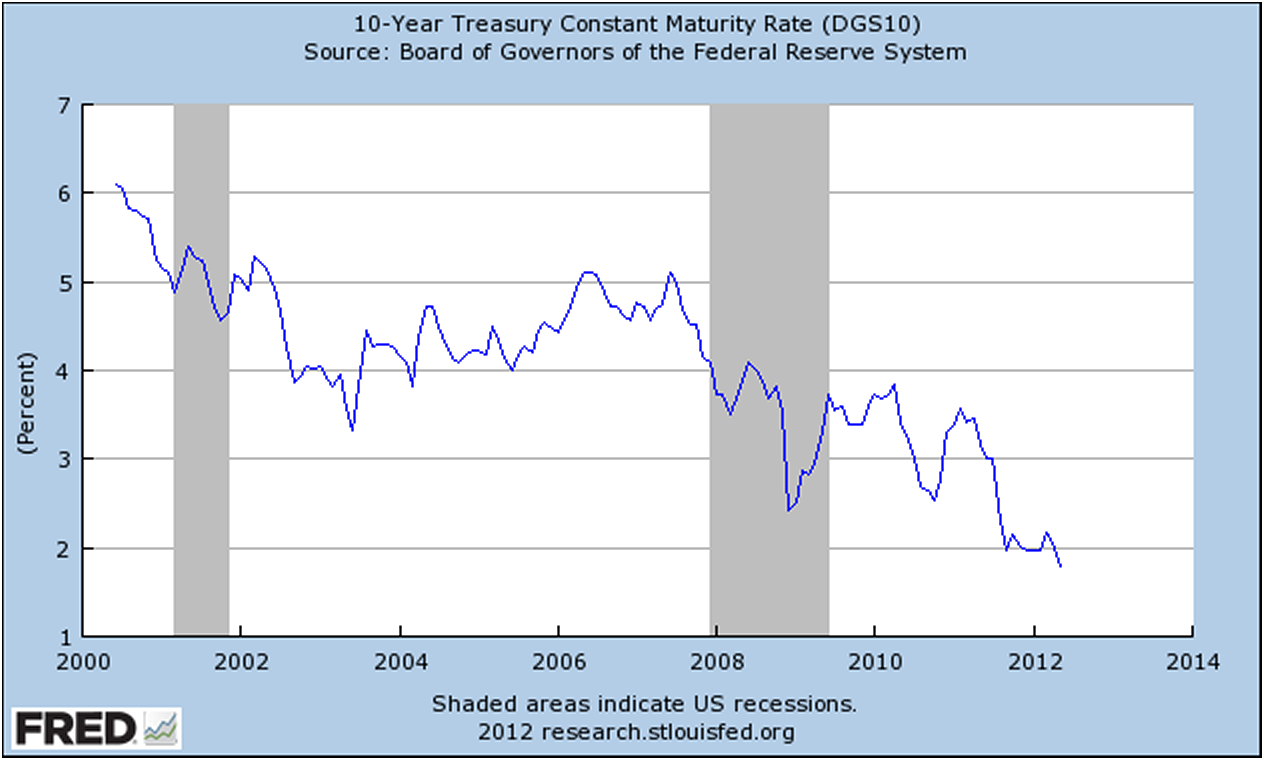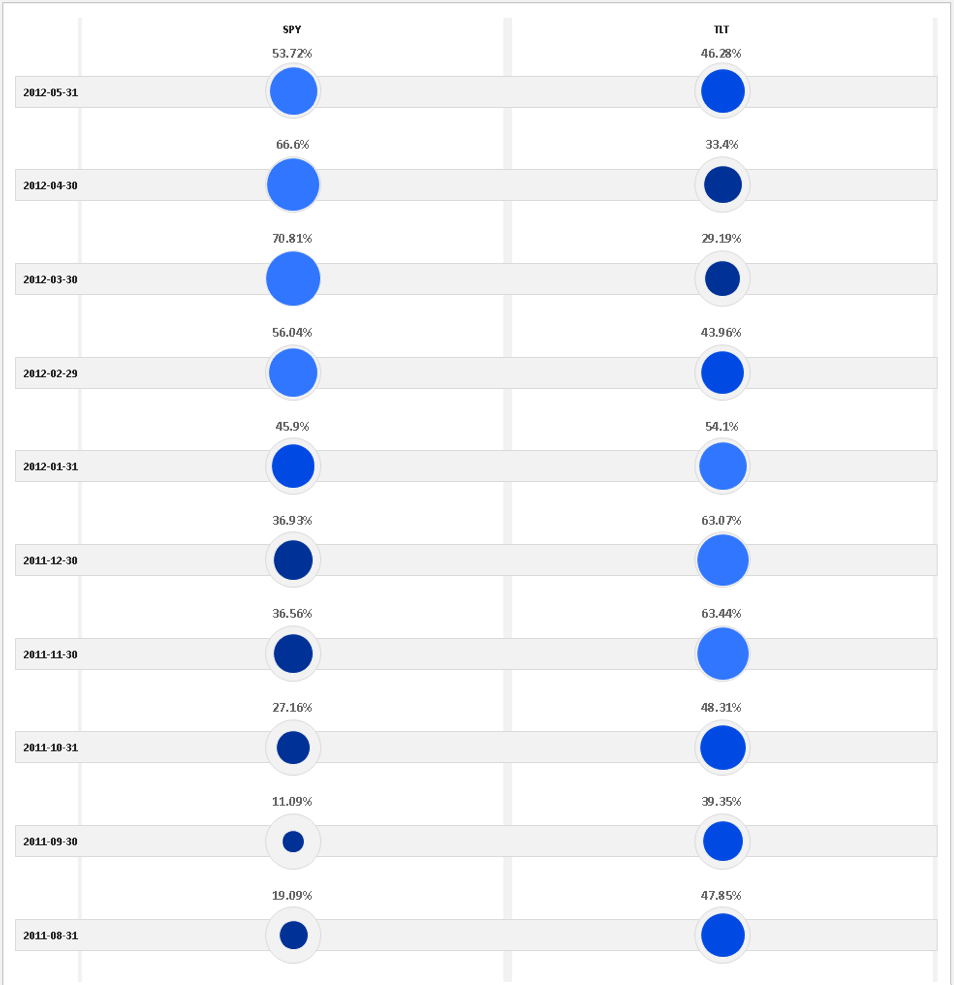Our last article described an Adaptive Risk Parity (ARP) framework for a stock/bond balanced allocation, and discussed the advantages and risks relative to traditional 60/40 approach. While ARP makes intuitive, logical and empirical sense as an allocation framework, there are long-term risks to this approach related to asset class regimes.
Stocks, bonds and other asset classes generally move through long periods of high total return followed by long-periods of low total return. While there is more contention about where we are in the long-term stock cycle, there can be little debate about whether we are closer to the end or the beginning of the long-term interest rate cycle.
The chart below from Mebane Faber's great new(ish) series on Risk Parity demonstrates the long-term efficacy of a static version of the approach for a portfolio of stocks and bonds using long-term relative stock and bond volatility for allocations, and targeting the same long-term volatility as the 60/40 portfolio (10.44%). Notice that to achieve the same level of risk as a 60/40 portfolio, the risk parity portfolio must be levered by 160%.
Chart 1. Long-term risk parity with S&P 500 and 10-Year Treasuries, 1972 - 2012

Source: Mabane Faber, 2012
While the performance of the static risk parity approach is better over the full period, Faber points out that the relative out-performance is sensitive to the start and end dates of the observation period. If we go back in time to mid 2000 and observe the relative performance over the first 28 years, we may have drawn a different conclusion.
Chart 2. Long-term risk parity with S&P 500 and 10-Year Treasuries, 1972 - 2000 
Source: Mabane Faber, 2012
So what happened during the last decade to create such a massive disparity in returns? The next chart offers a clue: it plots the progression of interest rates since 2000.
Chart 3. 10-Year Treasury yield, 2000 - 2012 
Source: FRED database
Clearly this has been an exceptional period for interest rates, as they have dropped by over 70% over the past 12 years, delivering almost 7.6% in total returns per year, compared with 0.80% per year for stocks.
The question is, with interest rates at or very near historic lows, and the relative return differential between risk parity and more traditional approaches at an all-time high, should we expect this approach to continue to dominate other approaches going forward? Or should we acknowledge that the best days for risk parity are probably behind us - and adapt?
Adaptive Asset Allocation (AAA)
In this article we will apply the integrated AAA approach described in our whitepaper to a more traditional stock and bond portfolio to create a resilient 'balanced fund' that is immune to the interest rate bias that represents the Achilles Heel of risk parity.
AAA uses estimates of returns, volatility and correlation for assets in a portfolio based on recently observed measures of these parameters, rather than long-term averages. These estimates are then integrated using a robust mean-variance optimization algorithm analogous to the equations described under the banner of Modern Portfolio Theory.
Estimates for returns and correlations are drawn from time series for each asset over a 6-month look-back horizon, while volatility is measured over a shorter 60 day horizon. Further, portfolio level volatility at each rebalance period is managed to a 10% target. Depending on the measured volatility of the assets, and the correlation between them, at each rebalance period, cash or leverage may be required to reach the volatility target. No yield on cash or cost of leverage is included for this illustration.
Chart 4. Adaptive Asset Allocation balanced portfolio, rebalanced monthly, 1995 - May 31, 2012
Max 200% exposure 
Source: Data from Yahoo Finance
For those with no tolerance for leverage or margin, here is a version of the AAA approach with a maximum 100% portfolio exposure.
Chart 5. Adaptive Asset Allocation balanced portfolio, rebalanced monthly, 1995 - May 31, 2012
Max 100% exposure
Source: Data from Yahoo Finance
You can see that the Adaptive Asset Allocation framework described in our whitepaper applies quite well to a typical balanced portfolio of stocks and bonds. To illustrate the adaptive nature of the program, the diagram below illustrates how the portfolio adapts its allocations over time based on changing momentum, volatility and correlation dynamics.
You can see that the starting allocation for June would have been 53.72% in stocks and 46.28% in bonds.
Chart 6. Adaptive Asset Allocation balanced portfolio, historical allocations, Aug 31, 2011 - May 31, 1012. Max 100% exposure. 
Source: Data from Yahoo Finance
Notice how during late 2011's extreme market behaviour, the AAA balanced portfolio dramatically reduced exposure to both stocks and bonds, lowering equity allocation to 11% and Treasury allocations to 39% at the end of September, with the balance in a 50% cash allocation. This was necessary to maintain the target 10% portfolio volatility during a period where the observed volatility was much too high.
Also notice that, for the most part, the allocations do not stray too far from the Investment Policy Statement (IPS) guidelines for a typical balanced investor. Where deviations do occur, they are usually biased toward too much cash, and rarely last more than a month or two except during extreme situations like 2008.
Fortunately, many IPSs have enough flexibility in their guidelines to to allow for deviations from stated benchmarks over periods up to 3 months, and longer deviations are allowed with appropriate client consultation.
As a result, while portfolio flexibility is an important and central element of the AAA framework, the examples above demonstrate that it is constrained enough to make it a compelling and comprehensive alternative for traditional balanced clients.
Conclusion
The November article 'Rebalancing Resurrected' introduced the concept of weighting portfolio allocations based on relative volatility rather than as a set portion of capital. It was shown that relative volatility sizing delivered a substantial improvement to risk-adjusted returns without sacrificing absolute returns.
The prior article on Adaptive Risk Parity was a natural extension to a volatility sizing approach because it applies the same math to allocate between the assets based on volatility, but then overlays a risk budget at the portfolio level. The ARP approach further improved risk adjusted performance with consistent absolute performance.
Further, by allowing the portfolio to take on a limited amount of leverage at times of low asset level volatility and/or very low asset correlations in order to achieve the target risk budget, the ARP portfolio delivered a 27% improvement in absolute returns with the same level of portfolio volatility as the traditional balanced portfolio.
Finally, in acknowledgment of the primary flaw in the usual risk parity approach - the structural overweight to fixed income - we applied an Adaptive Asset Allocation framework that applied better estimates of return, volatility and correlation to create rolling optimal portfolios. This framework delivered performance consistent with the ARP approach, but because it is guided by asset class momentum as well as relative volatility and correlations, it is robust to structural shifts in interest rate regimes.
Investors are looking for robust, adaptive investment solutions to manage indelible liabilities like funding objectives or retirements. Traditional SAA and endowment model 60/40 portfolios are vulnerable to long-term shifts in return, volatility and correlation regimes across asset classes. This risk is especially acute with interest rates at historic lows.
The Adaptive Asset Allocation framework offers a working solution for investors that provides strong returns with managed risk, a combination that substantially and positively skews the probability of success for investors, regardless of market outcomes.
- English (UK)
- English (India)
- English (Canada)
- English (Australia)
- English (South Africa)
- English (Philippines)
- English (Nigeria)
- Deutsch
- Español (España)
- Español (México)
- Français
- Italiano
- Nederlands
- Português (Portugal)
- Polski
- Português (Brasil)
- Русский
- Türkçe
- العربية
- Ελληνικά
- Svenska
- Suomi
- עברית
- 日本語
- 한국어
- 简体中文
- 繁體中文
- Bahasa Indonesia
- Bahasa Melayu
- ไทย
- Tiếng Việt
- हिंदी
Adaptive Asset Allocation For A Regime Agnostic 'Balanced Fund'
Published 06/16/2012, 01:25 AM
Updated 07/09/2023, 06:31 AM
Adaptive Asset Allocation For A Regime Agnostic 'Balanced Fund'
Latest comments
Install Our App
Risk Disclosure: Trading in financial instruments and/or cryptocurrencies involves high risks including the risk of losing some, or all, of your investment amount, and may not be suitable for all investors. Prices of cryptocurrencies are extremely volatile and may be affected by external factors such as financial, regulatory or political events. Trading on margin increases the financial risks.
Before deciding to trade in financial instrument or cryptocurrencies you should be fully informed of the risks and costs associated with trading the financial markets, carefully consider your investment objectives, level of experience, and risk appetite, and seek professional advice where needed.
Fusion Media would like to remind you that the data contained in this website is not necessarily real-time nor accurate. The data and prices on the website are not necessarily provided by any market or exchange, but may be provided by market makers, and so prices may not be accurate and may differ from the actual price at any given market, meaning prices are indicative and not appropriate for trading purposes. Fusion Media and any provider of the data contained in this website will not accept liability for any loss or damage as a result of your trading, or your reliance on the information contained within this website.
It is prohibited to use, store, reproduce, display, modify, transmit or distribute the data contained in this website without the explicit prior written permission of Fusion Media and/or the data provider. All intellectual property rights are reserved by the providers and/or the exchange providing the data contained in this website.
Fusion Media may be compensated by the advertisers that appear on the website, based on your interaction with the advertisements or advertisers.
Before deciding to trade in financial instrument or cryptocurrencies you should be fully informed of the risks and costs associated with trading the financial markets, carefully consider your investment objectives, level of experience, and risk appetite, and seek professional advice where needed.
Fusion Media would like to remind you that the data contained in this website is not necessarily real-time nor accurate. The data and prices on the website are not necessarily provided by any market or exchange, but may be provided by market makers, and so prices may not be accurate and may differ from the actual price at any given market, meaning prices are indicative and not appropriate for trading purposes. Fusion Media and any provider of the data contained in this website will not accept liability for any loss or damage as a result of your trading, or your reliance on the information contained within this website.
It is prohibited to use, store, reproduce, display, modify, transmit or distribute the data contained in this website without the explicit prior written permission of Fusion Media and/or the data provider. All intellectual property rights are reserved by the providers and/or the exchange providing the data contained in this website.
Fusion Media may be compensated by the advertisers that appear on the website, based on your interaction with the advertisements or advertisers.
© 2007-2024 - Fusion Media Limited. All Rights Reserved.
